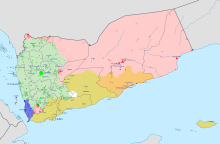Yemen model

The Yemen Model was the rubric for the Obama Administration's attempts to neutralize foreign terrorist groups hostile to the United States.
Strategy[edit]

US President Barack Obama often cited the Yemen Model as his vision for dealing with insurgent groups.[1][2]
Under the Yemen Model, the United States provided weapons, logistics, transportation and cash to a local proxy force, while committing no or few US troops.[3] The United States also carried out air strikes and targeted killings of suspected opposition leaders.
Naming[edit]

The model was named after the conduct of the United States' continuing conflict in Yemen. The US wanted to minimize the ability of the Al-Qaeda in the Arabian Peninsula (AQAP) group to attack US territory, while at the same time, the Obama Administration wanted to commit as few resources to the fight as possible.[4]
The United States picked a proxy force (in this case, tribes allied with government leader Abd Rabbuh Mansur Hadi), armed and trained them, and used them as a ground force against Al-Qaeda factions in exchange for US aid to the regime, totaling more than $600 million.[5] The United States also conducted a significant low-tempo air and drone campaign starting in 2009. The US also occasionally launched commando raids inside Yemen and did base some military personnel in and around al-Annad air base in the south of the country.[6]
The Obama Administration often defended its actions in Yemen as effective, and a model for other conflicts.[1][5][7]
Other American conflicts[edit]
During the early stages of the current American conflict in Iraq, Obama cited the Yemen Model as the inspiration for the conduct of the war.[1][7] He went so far as to mention Yemen as a model for success during his first speech about the new war in September 2014.[2]
The Administration also defended its efforts in Somalia as an outgrowth of the strategy.[8]
See also[edit]
References[edit]
- ^ a b c "In devising a plan in Iraq, U.S. looks to its Yemen model". Los Angeles Times. 2014-06-22. Retrieved 2021-11-17.
- ^ a b "Four months ago, Obama called Yemen's war on terror a success. Now the Yemeni government may fall". The Washington Post. 2015-01-20. Retrieved 2021-11-17.
- ^ Zimmerman, Katherine (2014-07-17). "Yemen model won't work in Iraq, Syria". The Washington Post. Retrieved 2021-11-17.
- ^ "Obama's love of the "Yemen model" sums up his disastrously shortsighted foreign policy". Vox. 2015-03-30. Retrieved 2021-11-17.
- ^ a b Shuaib Almosawa (12 September 2014). "Obama's 'Yemen Model' for the War on ISIS Is a Wreck". The Daily Beast. Thedailybeast.com. Retrieved 2021-11-17.
- ^ "Yemeni president demands Houthis quit Sanaa; U.S. evacuates remaining forces". www.reuters.com. March 21, 2015. Retrieved 2021-11-17.
- ^ a b Bruce, Mary (March 25, 2015). "White House Continues to Back Yemen as Model For Successful Counterterrorism". abcnews.go.com. Retrieved 2021-11-17.
- ^ "White House calls Yemen 'model' for ISIS fight, as security deteriorates". Fox News. 2014-09-29. Retrieved 2021-11-17.
